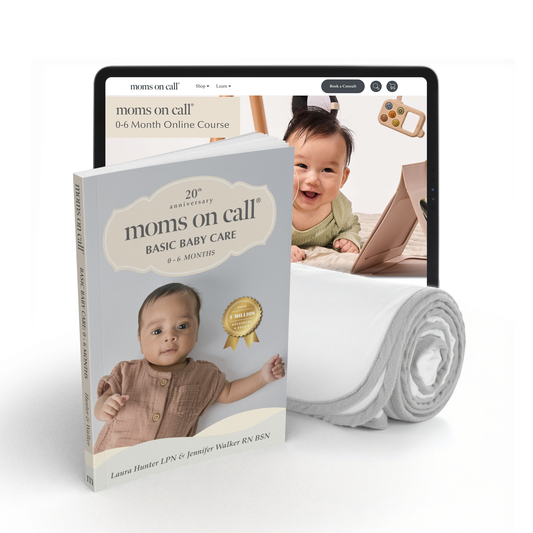While I was pregnant with my first daughter I had a birth plan. My plan was to stroll to the hospital (unaware and unprepared) and just push my baby out like the rest of them. I had my bags packed, newly manicured nails and make-up because -duh- pictures! Then, the realities of labor and delivery came crashing in! Have you ever heard of anal fissures? Yeah, me either until that day! After that moment, I vowed to help revolutionize prenatal prep! I decided to devote my career to educating and empowering women for this magnificent moment!
Preparing and recovering from childbirth should not be a mystery - yet so many women are left on their own to just figure it out! This is the reason we have teamed up with Moms on Call to help demystify childbirth prep and recovery. When they say it takes a village - believe them! And then let us be a part of it!
So, Why Prepare Anyway?
Well for one - it’s much nicer NOT having paper cuts in your anus while taking care of a newborn, I promise! Properly preparing your body for childbirth can decrease risks of perineal tearing, prolapse, hemorrhoids, improve pushing times, and aid in a quicker postpartum recovery! That’s a big yes for us!! Did you know that you burn up to 10,000 calories during labor and delivery? That’s like running a marathon twice! So let's get ready to train mama!
3rd Trimester Preparation:
Prepping the pelvic floor muscles can reduce the risks of tearing to a grade 3 or 4. What exactly does that mean? Perineal tearing is common in vaginal deliveries and occurs when there is a tear in between the area of your vaginal and anal opening.
There are 4 grades of tearing:
- 1st degree tears: Involve only the skin of the perineum and typically heal on their own.
- 2nd degree tears: Involve the skin of the perineum, perineal muscles and fascia. Often require stitching.
- 3rd degree tears: Involve the skin, perineal muscles, extending to the anal sphincter. Require stitching.
- 4th degree tears: Involve the skin, perineal muscles, and anal sphincter into the anus. Require stitching.
Here’s what we recommend:
-
Manually stretching the perineum.
-
Prepping the perineum for delivery.
- The goal of this activity is to reduce your risk of perineal tearing during the birth of your baby.
- Performing this activity daily for the last 6 weeks of your pregnancy has been shown to increase the flexibility of your perineum for birth, decrease the risk of perineal tearing or need for episiotomy, and helps you get accustomed to the sensation of “crowning” during birth.
- While some women find this activity to have some mild discomfort for the first week or two, most say that this discomfort goes away. Women who performed this massage prior to birth say they felt more in control of their pelvic floor muscles and more prepared for birth.
-
Prepping the perineum for delivery.
- Pelvic Floor Lengthening Exercises

Deep Squat 
Child's Pose 
Happy Baby
-
Knowing how to push
- The typical instructions you will receive from your doctor or midwife are for you to take a deep breath in and then push as hard as you can while you hold your breath. Usually you will do this for a count of 10 and then relax. We DO NOT recommend this method as it puts a lot of stress on your pelvic floor and can lead towards specific issues/dysfunctions in your postpartum phase, especially the longer you push!
-
Knowing optimal birthing positions
- If you are delivering in the hospital, it is very likely your doctor or midwife will have you on your back to push.
- However, this is not the most optimal position for pushing!
- Believe it or not, sidelying, squatting or on all fours (hands and knees) helps open up the pelvis more effectively and makes it easier to push baby out.
- If you decide on an epidural, you can still get into sidelying (with some help) and have a nurse or your partner hold your top leg up towards your chest.
4th Trimester Recovery:
We recommend you start moving and rehabbing your body during those first few weeks at home! We get little to no instruction once discharged on how to take care of ourselves after delivery. We get sent home with our new fresh baby and no follow up or communication for 4-6 weeks! This blows our mind! So, we have a few suggestions to facilitate proper healing and when to call doc if needed!
Do NOT skip your postpartum visit with your provider! Yes, many times the visit is very basic but it is important for you to be examined and get cleared prior to returning to your previous level of exercise.
We urge everyone to get an assessment from a pelvic floor physical therapist; the following exercises do not replace that! This is just a guide to help get you started on your recovery journey.
Revelle is a women’s wellness practice that specializes in treatment for the common but abnormal issues women experience throughout their lifetime. We focus on pelvic floor dysfunction, pregnancy, and postpartum. We empower women to prioritize self-care to ensure they are functioning at their absolute best! Wondering why you should see a pelvic floor PT? Check out our website to learn more! Revelle — Women's Physical Therapy
Click the image below for your special freebie from Revelle for Moms on Call Subscribers!





























